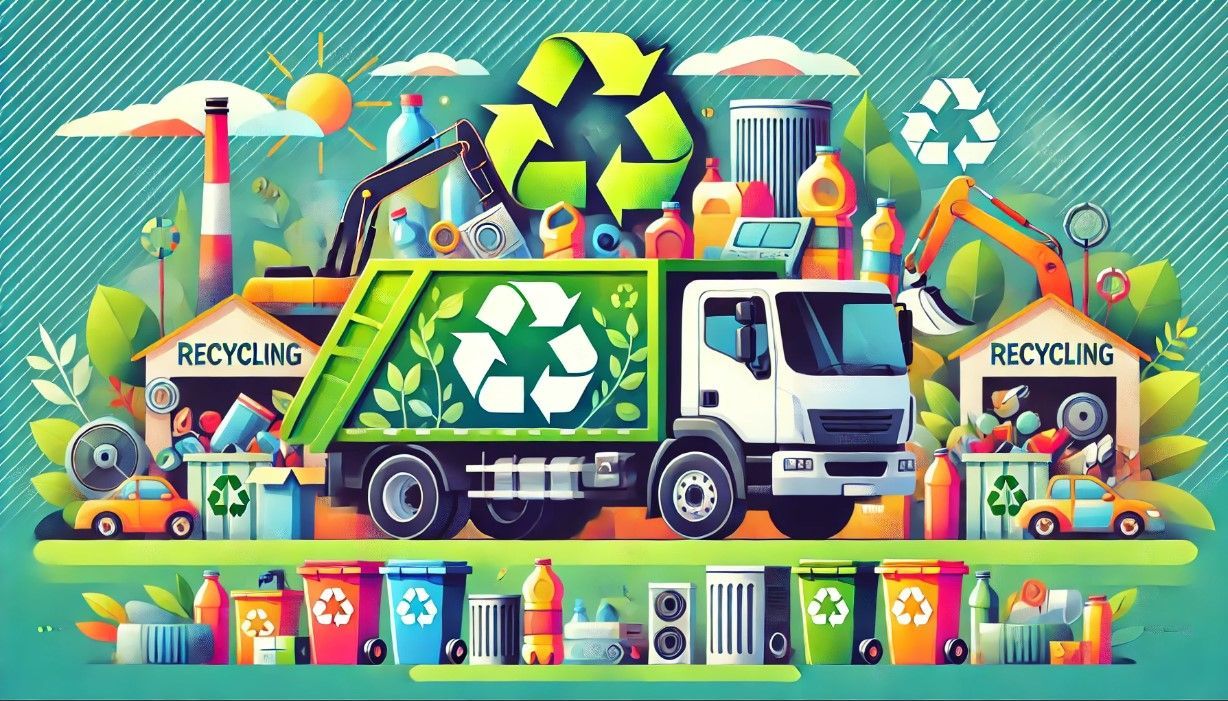How to Recycle Unwanted Items and Declutter Responsibly
Decluttering feels great. But getting rid of unwanted items doesn’t mean they should just go straight to the landfill. Recycling unwanted items is not only an eco-friendly way to declutter but also a way to give new life to things you no longer need. From
old electronics to clothes and furniture, almost everything has a better place to go than the trash. In this guide, we'll show you how to recycle unwanted items responsibly, step by step.
Why Recycling Unwanted Items is Important
- Reduces Waste in Landfills: Many items, like electronics and plastic, can take hundreds of years to break down in a landfill. Recycling keeps these materials out of landfills.
- Conserves Natural Resources: Recycling items like paper, metal, and plastic reduces the need to extract raw materials from the earth.
- Promotes a Circular Economy:
Giving items a second life—whether through recycling or repurposing—helps sustain an economy that keeps products and materials in use for longer.
How to Start Recycling Unwanted Items: A Step-by-Step Guide
1. Sort Through Your Items
The first step to recycling is to sort through your unwanted items. Organize them into categories:
- Recyclables: Glass, plastic bottles, metal cans, paper products.
- Donations: Usable items like clothes, electronics, toys, and furniture.
- Hazardous Waste: Batteries, paint, electronics that require special handling.
- Trash: Items that can't be recycled or reused.
| Category | Examples |
|---|---|
| Recyclables | Cardboard boxes, plastic bottles, aluminum cans |
| Donations | Clothing, furniture, small appliances |
| Hazardous Waste | Batteries, paint, electronics |
| Trash | Soiled paper, food waste (if not composted) |
2. Research Local Recycling Programs
Every community has its own recycling guidelines. Check your local waste management service for information on what materials they accept and how to prepare them. Some areas have curbside pickup for recyclables, while others require drop-off at a recycling center.
3. Find Donation Centers or Charity Shops
For items that are still in good condition, such as clothing, toys, and small household items, donating is a great option. Many charities, thrift stores, and non-profits accept donations of gently-used goods. Some even offer free pickup services.
4. Use a Junk Removal Service with Eco-Friendly Practices
If you have a significant amount of junk to get rid of, hiring a junk removal service that recycles or donates items is a convenient option. Many junk removal companies prioritize recycling and will make sure items are disposed of responsibly.
5. Separate Hazardous Waste for Proper Disposal
Hazardous materials like batteries, paint, and electronics require special disposal. Many communities have hazardous waste disposal days or designated drop-off centers to handle these items safely.
Recycling Common Household Items
Not sure how to recycle certain items? Here's a handy guide to some of the most common household recyclables:
| Item | How to Recycle |
|---|---|
| Electronics (E-Waste) | Drop off at electronic recycling centers, retail take-back programs |
| Batteries | Bring to hazardous waste facilities or stores with battery recycling |
| Furniture | Donate to charities, repurpose, or find junk haulers who recycle |
| Clothes and Textiles | Donate to thrift stores, recycle at fabric drop-offs, upcycle as rags |
| Appliances | Schedule a pick-up with local appliance recycling or junk removal service |
| Plastic Bags | Return to designated drop-off locations at grocery stores |
| Glass Jars and Bottles | Rinse and place in curbside recycling (where accepted) |
Benefits of Recycling Unwanted Items
1. Reducing Your Carbon Footprint
Recycling items like paper, metal, and plastic helps conserve energy and reduce the carbon emissions produced by extracting and manufacturing raw materials.
2. Supporting Local Charities
By donating usable items, you're giving back to your community and supporting local non-profits, shelters, and thrift stores that rely on donations.
3. Saving Money and Space
Recycling means you're not wasting space in your home with items you no longer need. You can also save money on disposal fees by reducing the amount of waste you throw out.
4. Conserving Natural Resources
Recycling helps conserve valuable natural resources. For example, recycling one ton of paper saves 17 trees, and recycling one aluminum can save enough energy to run a TV for three hours.
FAQs on Recycling Unwanted Items
Q1: Can all plastics be recycled?
A: Not all plastics are recyclable. Check the number on the bottom of the container (usually within a recycling symbol). Plastics labeled #1 and #2 are commonly recyclable, while others may require specialized recycling.
Q2: How do I recycle electronics?
A: Electronics like computers, phones, and TVs contain materials that can be recycled but must be processed properly. Look for local e-waste recycling centers, retailer take-back programs, or junk removal services that handle electronics.
Q3: What do I do with old paint or hazardous chemicals?
A: Hazardous waste like paint, pesticides, and chemicals require special disposal. Contact your local waste management service for drop-off days or designated hazardous waste facilities.
Q4: Can I recycle clothes and textiles that are damaged?
A: Yes! Even if clothes are not fit to be donated, many textile recycling programs accept damaged or stained items. These materials can be repurposed into rags, insulation, or other recycled products.
The Role of Junk Removal Services in Recycling
Hiring a junk removal service can make recycling unwanted items easy and hassle-free. These services do more than just haul away junk—they often sort items for recycling, donating usable items to local charities, and ensuring that hazardous materials are safely disposed of. Here’s how junk removal services support recycling:
- Sorting Items: Junk removal teams sort items to determine what can be recycled, donated, or properly disposed of.
- Partnering with Charities: They work with local non-profits and shelters to donate furniture, appliances, and other usable items.
- Environmentally Responsible Disposal: Items like electronics, appliances, and hazardous materials are disposed of according to environmental guidelines.
What are some creative ways you’ve recycled items in your home? Have any tips or experiences with junk removal services that prioritize recycling? Share your thoughts in the comments below!
Making Recycling a Habit
Once you’ve sorted and recycled your initial pile of unwanted items, make recycling a part of your routine. Here are a few simple ways to create an eco-friendly habit:
- Set Up a Home Recycling Station: Create a designated area in your home to sort recyclables, donations, and trash. Make it easy for everyone in the household to separate items properly.
- Educate Your Family: Teach your family members about what items can and cannot be recycled. Create a simple chart or list to hang near your recycling bins as a reminder.
- Stay Updated on Local Guidelines: Recycling guidelines change, so stay informed about what your local waste management service accepts and how to prepare items for recycling.
Recycle, Repurpose, and Reduce Waste
Recycling unwanted items is a great way to declutter while also making a positive impact on the environment. By sorting through your items, finding donation centers, and using eco-friendly junk removal services, you can responsibly get rid of junk while giving it a new life. Ready to start recycling? Go through your home, see what items you no longer need, and find the best way to recycle them responsibly.
Contact us
If you have any questions or need any assistance after business hours, please get in touch.
Phone
BUSINESS HOURS
- Monday
- -
- Tuesday
- -
- Wednesday
- -
- Thursday
- -
- Friday
- -
- Saturday
- -
- Sunday
- Closed
All Rights Reserved | Alpha Dog Junk Removal


